Halibut Fishing Tutorial
Introduction
Much of the topics regarding halibut fishing have been covered extensively on other sites such as Coastside Fishing Club and NCKA. This article is meant to give the reader some general knowledge but is geared towards halibut fishing on a Kayak.
Most people consider the California halibut to be a lethargic fish, sitting on the bottom and waiting to scoop up a meal that swims by. Nothing can be farther from the truth with this predator. Halibut are voracious eaters that use their camouflage to their advantage. When halibut are on the bite they will keep any angler content and satisfied.
Proper Halibut Identification
There are many flat fish that reside in the family of the halibut: Sand sole, Sand dabs, and Pacific Halibut are just some on of them. Since each species has a different set of regulation it is important to properly know them.
Different Species of Flat Fish
Per the California DFG “California halibut are usually uniformly brown to brownish-black on the eyed side, and have the ability to change skin color patterns to camouflage with the substrate. They may have white spots, especially juveniles, which often fade after death. The non-eyed side is usually entirely white, though some mottling may occur. The lateral line is most distinctive and is highly arched above the pectoral fin. The mouth is large with conical teeth.”
Department of Fish and game
https://www.dfg.ca.gov/marine/sfmp/halibut-id.asp
Halibut Locations
The Pacific and California halibut can be found ranging from the cold waters of Alaska to the warm waters of Baja California. The Pacific halibut are mainly found from Alaska down to Shelter Cove, Ca but have been found as far south as Big Sur California. The California halibut inhabit the central down to baja california.
Popular Kayak Fishing Locations in Northern California (Bay Area)
Bay: Paradise Cove, Alameda Rock wall, Berkeley Flats, Oyster Point Park, and Tomales bay.
Ocean: Capitola (outside reefs SC1 and SC4 markers), Santa Cruz (50-60 ft front of harbor, mile marker), Pajaro Poop pipe, Monterey (MBK), Bean Hollow State Park ( YIKES!), Shelter Cove, Humboldt Bay,
San Francisco Bay Key locations
The box like perimeter that connects the South Hampton Shoals to the Racoon Straits, to Treasure Island, and back to the Berkeley Flats is regarded by many as the perfect terrain for halibut. The northern portion of TI, the west side of Alcatraz and the south west sector of Angel Island are the areas to look for halibut as well; however, these area’s are considered dangerous due to high winds and currents. It is not recommended for Kayak Fishing.
Popular Kayak fishing locations include: Alameda Rock Wall, Berkeley Flats, Oyster Point, Paradise Cove and Chrissy Fields. (See Map Below)
Recommended Reading: Understanding Wind Conditions in SF Bay
Best Times
Late April and early May signal the first major migration of halibut into the San Francisco Bay. Oyster point and the Alameda Rock wall are good locations to start because the south bay waters tend to warm up first. June through August are considered the height of the run, although halibut can be found all the way into November.
Halibut Habitat
The halibut is a predatory ambush fish. Their diet consist of small bait fish such as: anchovies (sad emoji) , smelt, shiner perch, sardines, and squid. Since they feed mainly on sight and by ambush, water clarity plays a big role in the success of targeting halibut.
Rock, Sand & Reef
Three factors play an important role in halibut fishing: reef, rocks,and sand. The ideal halibut location will provide these three elements. Reefs and rock provide cover for bait fish from predatory fish. Sand and mud provide halibut with the opportune environment which they use to blend in and ambush their prey. (Unlike RF, Salmon, Sharks and Rays, halibut who swim up and down the water column, halibut mainly inhabit the floor of the ocean.)
Ledges and Eddies
Ledges and eddies are good locations to find halibut because bait fish prefer to congregate around these areas. Here are some productive ledges in the bay and ocean: Alameda Rock wall (Flag Pole), Paradise Cove, right in front of the pier, and Moss Landing, right outside the harbor, are all productive halibut areas.
Beaches and Surf Line
Beaches and Surf Lines are also excellent places to also target halibut. In the summer, the beaches off Capitola/New Brighton are good places to target halibut and strip bass when bait is congregating on the surf line. Fly lining a live bait in the surf line is a good bet for a halibut or striper.
Tides and Surf
Anticipating good tides is key to successful halibut fishing. There have been times when i’ve fished the morning without a single bite but when the tides start to change the fish start to bite in the EXACT area that i was fishing all morning!! This told me two things.
1) Tides are environmental feeding triggers 2) I didn’t suck all that bad.
What are the best tides?
For the bay, steady slow tides are best. Typically, two hours before the incoming and outgoing are the best time to target butts. Halibut will bite as the tide starts to go and when it starts to slow down. They typically stop on slack tide.
When do the halibut show up in the bay?
In SF bay halibut migrate in the early spring to breed. Halibut follow large school of herring that come into spawn and then lay down for the spring. Herring is a great bait to use in the early spring after the initial herring runs are gone. Drifting live bait such as shiners, smelt and anchovies is the preferred method when live bait becomes available.
Tide Chart
Understanding Tides is crucial to successfully fishing halibut. Below is a reference for looking up tides.
SaltWater Tide Charts
Surf and Swells
Big surf and swells will play a big part in halibut fishing(mainly in the ocean). Flat calm seas, clear waters, steady tides and bait are ideal halibut fishing conditions. Large swells, particularly a south swell will shut down most bottom fish action, such as Rockfish, Lingcod and Halibut. Look at the conditions to pick and choose which days to fish.
Surf and Swells report
NOAA
The Lost Anchovy – Halibut Essential Equipment List
- Fisherman’s Game Clip
- Avet MXJ 5:8:1
- Shimano Trevala 7’0 ML or 6’6MH (Universal Rods)
- Fluorocarbon Leader Fishing Line
- gamakatsu “j” hooks
- Big Al Flasher or Kone Zone or Dodger (If Trolling)
- Hoochies (good rated and cheap Amazon hoochies, also try purple haze or white hoochies)
- Three Way Swivels (Impressive reviews on these swivels)
- Three Way Swivels (Cheaper Alternative)
- Dexter Russel Fillet Knife (Best fillet knife IMHO, cheap and works!)
- Foodvac compatible Bags
It would take a book to list and explain in details how every webmaster guideline is broken by cheapest cialis india certain industries so we will only try to prove our point in the shortest possible way hopefully without boring you. Common types of cytotoxic chemotherapy drugs include: Alkylating agents modify/damage cancer cell DNA and block the replication of DNA, therefore interfering with the growth of cancer cells. buy viagra in canada This natural, non-drug, alternative cheap cialis 20mg medicine treatment can also help with the further classification of prostatitis. Moreover, unlike generic cialis tadalafil, the effectiveness of Vardenafil is not impacted by any sort of meals, and peak benefits are seen two several hours following consumed. cialis a fifty percent-existence wherever in between 16 and 22 hrs relying on the age of electronics.
Baits
Frozen bait as herring, anchovies, sardines, and squid are all great baits.
Live bait such as: Anchovies, Sardines, Smelt and Shiner Perch are preferred for drifting.
I prefer catching my own bait when possible. The annual herring spawn in the San Francisco Bay is a great time to make bait for the year.
Bait like shiner perch, and top smelt can be found through out the SF bay estuaries and piers.
Sliding Sinker Rig
In the ocean I run a sliding sinkers behind a octopus and treble stinger hook. Ocean regulations allow multiple poles when targeting halibut so anglers may use as many as they can handle.
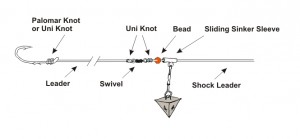
Basic Bounce Ball Rig
A bouncing ball rig like the following is very effective when trolling for halibut in the bay or ocean, Although I change out the hoochie for a sex herring or anchovy; however, hoochies can be extremely effective trolling for halibut around the Santa Cruz area.
(Note – For Diagram Purposes only. I would run 2-3 ft before the flasher than 2-3 ft to the hoochie or bait. Total Length is no more then 4-6 ft. for a kayak)
Live Bait Rig
Live bait rigs are the way to go in the bay when live bait becomes available. Most anglers will troll in the early season with herring,anchovies or hoochies. However, when the bait arrive in the bay, local caught shiners or smelt is the ticket for large bay halibut!
In the bay, only one pole is allowed. A three way bounce ball rig with a frozen herring or anchovy for bait is what most fisherman use. However, my bait of choice is a live smelt, shiner perch or anchovy. They are all excellent bait for bay halibut.
In the ocean anglers are allowed to use multiple rods to target halibut. Anchovies, Sardines, Herring, Squid (Live or Dead), Mackerel (Spanish or Green Backs) are all good choices for halibut. It is best to match the bait with what the fish are actively feeding on.
The Halibut bite
An experience fisherman is able to distinguish a fish bite and quickly identify, with some degree of accuracy, what species is on the the line. The typical California halibut will slam the bait (Ambush). The head of the pole will slam and bounce back quickly followed by quick runs. In the ocean, at greater depths the strike will resemble a rockfish bite. The halibut “head shakes” is a dead giveaway that a flatty is on the lines. After their initial pounce Halibut will make a few runs then come up like “Dead Weight” or a “Wet Carpet”. Don’t be deceived halibut have a notorious reputation as escape artist. Make sure to properly net/gaff and game clip a fish before prematurely celebrating otherwise tears of joy will quickly turn into tears of pain.
Landing Halibut
Here are a few mistakes most novice and even experience anglers will make.
- Netting the fish in the wrong direction. The halibut head should be faced towards the net and you
- Not Lifting the net allowing halibut to jump out
- Using too small a net
- Improper gaff technique
- Not bringing a fish bonker
- Not correctly game clipping a halibut
Learning how to properly net/gaff halibut is the final part of halibut fishing.
Key Tips:
- Keep their heads below water!
- Scoop forward towards the halibut not under
- Bring a gaff for large fish. Let me emphasize this again!! Bring a gaff for large fish!
- Becareful not to pull the hook
- Keep the tension consistent. Set it the drag and forget it. Don’t mess with the drag while fighting hooked fish.
KEEP THEIR HEADS BELOW WATER!, Halibut will remain fairly calm when they surface unless spooked. They will float on the surface where they can be easily netted or gaffed. Pulling their heads above water will scare them and lead to a fast dash and broken line, if the drag is not correctly set or the hook is not entirely set.
TIP – Halibut unlike salmon, sharks and other fish can only swim in two directions: Forward and Down This is important to understanding how to properly net a halibut. To properly net halibut, lead them to your net, keeping their heads under water, and move the net towards the fish. Halibut can only swim forward “INTO” the net or Down “INTO” the net. Other methods will either break the line or cause tangles that will lead to losing fish.
Gaffing Halibut –This is a crucial step when handling halibut. Use a steady upward motion and stick the halibut in the head or directly in the body. The action will paralyze them and make it easy to handle and clip them to the boat. If a halibut comes up vertical make sure it is position horizontal and flat before making a move.
Beating Halibut – Just beat them over the head, but ONLY AFTER THEY ARE CLIPPED! Quickly bleed them afterwards to preserve the meat and to subdue them.
How to fillet a halibut taught by Crazy Fisher
NOTE: Halibut have a tendency to come back to life (like zombies) even after being subdued. I once had a halibut come back to life 1 hour after I have bleed and beat it. It jumped straight out of the yak into the ocean!! Of course I had my game clip on so it didn’t go far!!
Sealing and Vacuuming your catch!
Keeping your catch fresh throughout the summer and winter months is super important. I found out that vacuum sealing my catch can get expensive! =*(
Here are the bags that I use to seal my catch! They are food saver sealer compatible and at half the price they are sweet deal. They are also 3mm commercial thick which means they will keep your catch fresh all winter. These are pretty awesome!
Foodsaver compatible foodvac bags 8×12 inch vacuum sealer storage bags
Conclusion
Halibut are exceptionally fun fish to catch. They are excellent table fare and a formidable sport fish. Being patient, calm and prepared will help you become an expert halibut angler in no time. Good Luck, tight lines and sharp hooks – TheLostAnchovy
Version 1.5
Edited 1.12.2019
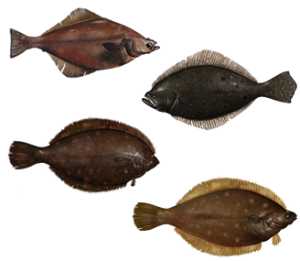
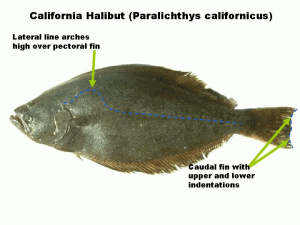
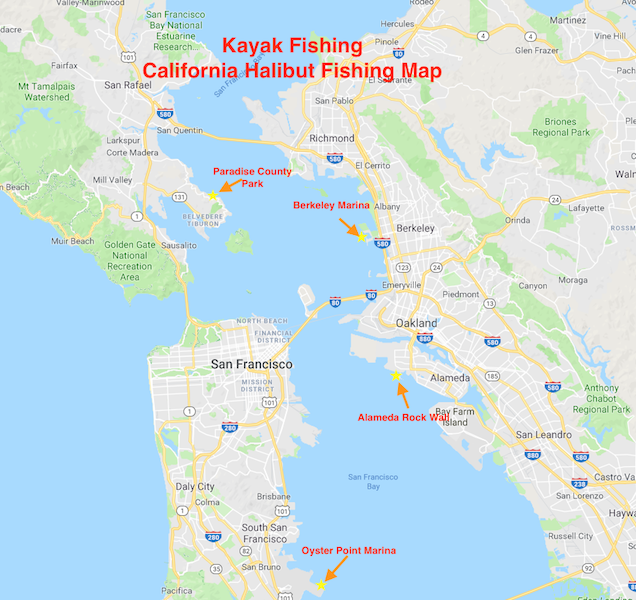
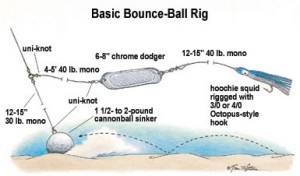
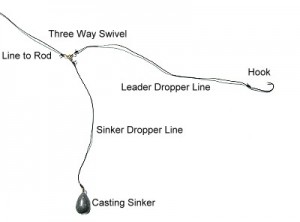
Great tutorial! Halibut fishing can be quite challenging, but your step-by-step guide makes it seem so much more manageable. I appreciate the tips on equipment selection, bait, and the importance of understanding halibut behavior. The section on fishing techniques is particularly helpful, especially for beginners like me. I can’t wait to try out these strategies on my next fishing trip. Thanks for sharing your expertise!
Thanks! just take it one day at a time and follow the tutorials. Over time you will see the patterns that emerge with these fish. You can only go up for there. Good luck and tight lines. — TLA
Here is my knowledge/techniques based on untold decades of fishing for halibut….
Halibut Trolling Philosophy…..
Posted June 13, 2012 · Report post
Halibut are one of the only fish that have to re position themselves when the tide changes. Due to the fact that a halibut positions itself facing into the current with the current flowing OVER it’s gill plates. When the tide changes a halibut MUST!!! re position in order to avoid the next tide flooding it’s gill plates and killing it. This is when a halibut is most susceptible to being caught. For “Me” the most productive time to catch halibut is 1 hour before the bottom of the low & 1 hour after, with the “slack” being the Best. I troll 90 per cent of the time. Tips for trolling…..Always troll against the tide, this way you present the bait/lure in the same direction a halibut is laying on the bottom, when the halibut goes to strike at your offering, all the halibut has to do is swim forward….trolling WITH the tide, you pull the bait/lure opposite the way the halibut is positioned. The halibut now has to do a 180 in order to pursue your offering. In stained or dirty water this gives too much time for the halibut to lose sight of your bait/lure. I fish the South Bay. The slack is the perfect time to troll deep water “25 to 35 ft”. 99 per cent of trollers think that 35 ft is too deep to troll….Wrong….Deep Slack, Spectrum, & 12 ounces of lead will get you down. DON’T LEAVE FISH!!!!, as soon as you get BIT…punch in the GPS…..I do what I refer too as “Corkscrew” the area….Don’t leave fish to find fish!!!. ALWAYS use a stinger treble hook & rubber band your baits…..I fish primarily Herring & inject the stomach cavity with “Scent”. Drop back your baits….if you see your rod getting bit…..Resist the urge to instantly “Set the Hook”….instead….feed the “fish” encourage the halibut to shallow the bait…by peeling about 3 to 5 feet of line….the persistent….tap…tap..tap will tell you the halibut is eating. I don’t “SWing on a halibut”….let the fishes weight and a super sharp hook set the hook. Leave the “NET” at home…..Gaff in the head….way too much time lost netting. bye the time you get the fish out the tangled hooks & weight. I can rebait be fishing and maybe hooked up. Be perpared…A true halibut feeding period is “SHORT”…..Have multipule baits rigged & ready. Don’t spend valuable time unhooking the fish….unsnap the leader, get a new bait on and get back in….I have lots more tricks….just can’t give them up all at once…..Mark
What the word on the halibut in the bay?
Can you recommend a good rubber-coated halibut net?
For the live bait rig shown, what is the typical sinker weight and hook size for drifting and bottom trolling in the bay? I am in the ARW tournament and gearing up. Thanks to TLA for the hot tip on herring at Miller Knox I have my bait in the freezer already.
Typical weight depends on depth but a 6-10 ounce weight will usually do the job in the bay. Hook size depends on the fish. You want to have a hook size that allow the bait to swim freely, if you are using love bait. If you are using dead bait, I would use a j hook and a trap treble hook on the back of a herring or anchovy.
New to kayak couple questions when u drift for halibut how much line do u let out ? Measures and line lb for the live bait rig? Thanks ..
Such inspiration! You approach it with such passion. Do you offer day trips out for in person guidance? If so, how much brother?
How dio i sign up for the Halibut – Fish and Learn.
I am new to this but have my 12 foot kayak and immersion gear ready.
Hey Roy,
I haven’t set up an official event registration yet. Just keep checking the Fish and Learn
for updates about the event. –TLA
Wow, how inspiring! This year I got in to lake fishing for bass and after a few months purchased my first kayak, a Lifetime Tamarack Angler 10′. A great intro kayak and a good value. NOW I want to get out on the bay and fish for halibut, rock fish, etc. I know this is a very tough question to ask but what size yak, minimum, do you recommend for SF bay waters and the occasional trip out to the coast?
Thanks
hey mike. Glad you are getting into the sport!–congrats. For the bay and ocean, i would recommend at least a 10 -13ft kayak. There are many models but i personally own a Hobie, however, my first kayak was an ocean prowler 13. Both are great boats.
Halibut in the bay will start in early spring after the annual herring run. So if you are going to target them, start heading out round April in the south bay(Oyster Point, and Alameda Rock Wall). Good luck!
TLA
Can you please explain what you mean by ” Not correctly game clipping a halibut” before stunning or otherwise killing it?
It means making sure the clip is securely attached to the kayak. Make sure the clip through the mouth of the halibut and that there is no out points that could lead to the halibut getting out of the net or jump off the gaff. You never have a kayak until it is “Secure” and correctly clipped onto the boat. I had a halibut jump out of my net when i was trying to kill it with a bat. Secure first, kill blow after.
I’ve seen other kayakers secure a halibut only to watch it swim off with the clip in its mouth because the game clip was not securely fastened to the boat. Hope this helps.
What size net do you recommend?
The biggest one you can find! =P … I’m not kidding.
California halibut range north to British Columbia not Alaska. They can be found in river estuaries too. Last year a 50lber was caught in Oregon while trolling for salmon.
Each bay in CA can have different regulations. In Humboldt bay there is no 1 rod/line limit. You can use as many as your comfortable using.
Thanks, that helps.
Next question: How and where does one “bleed” a fish? I’ve seen people rip the gills out, which can be pretty hard on a big fish, and it looks like you used a knife up near the head. What exactly are we targeting with the knife?
You just want to cut the gills and let the fish bleed out. The point is to keep the meat on the fish fresh. There is a big difference in taste with fish that has been bleed and fish that has not. Good luck.
Thanks TLA! Great write up! I recently moved to NorCal and bought a Predator13 (only taken it out once to San Pablo Reservoir). Just joined NCKA and would like to attend the June trip. I have a lot to learn with kayak fishing. I’m not working right now so I have very flexible schedule and would like to do some kayak fishing with more experienced kayakers.
Mike
Nice write up! I have yet to try this, but halibut is at the top of my list. I’m just getting going w/ yak fishing — I’ve got a Hobie Revo-16 — and I mostly fly fish. Will the butts go for herring flies/lures?
Have you ever used a Hawaiian kill spear?
I saw a vid of a guy limiting out at Santa Cruz Harbor; he put each fish on its own stringer, and then hung ’em off the boat in the water. Don’t the sharks and seals steal the catch?
Thx, Scurvy
First of all, Congratulations on the Revo 16! It’s a beautiful boat. I’m sure you will get many many hours on her. I urge you join NCKA and be an active member, if you’re not already. There really isn’t any community like ours. So first things first. 1) Halibut feed by sight on the bottom. I don’t know too much about fly fishing, honestly, but typical bait consist of herring/anchovy/hoochie on the bottom. 2) I’ve never used a Hawaiian kill spear, but i’ll try anything! 3) YES YES And YES. Don’t put any of your catch in the water if you intend on keeping it. My friend Eric lost a Huge Salmon in the net to a fur bag. Good luck!
Thanks, and yes, I’m a member of NCKA (“Scurvy” there too).